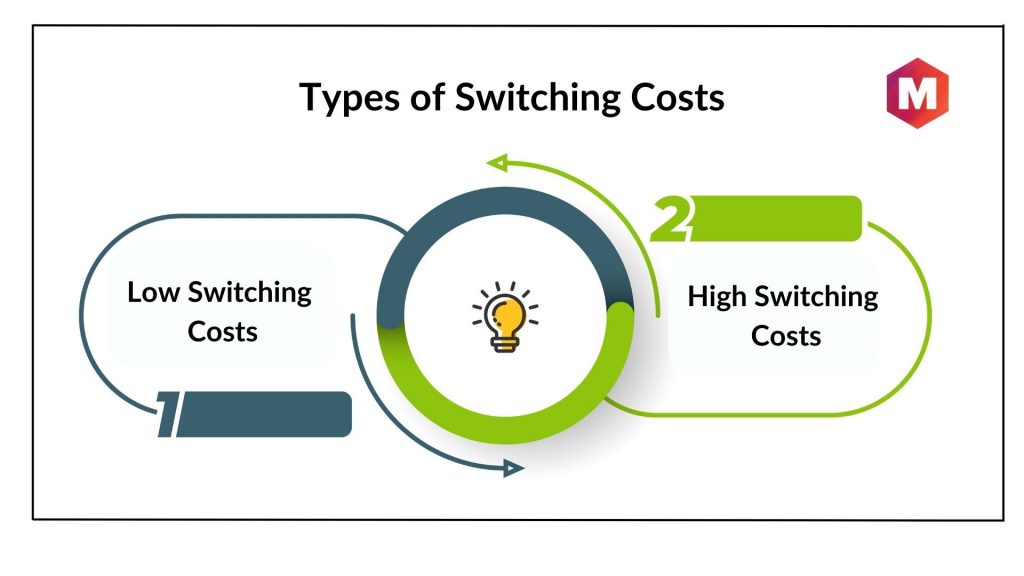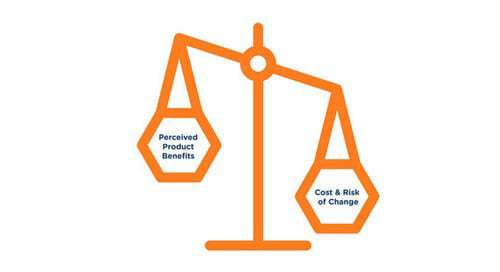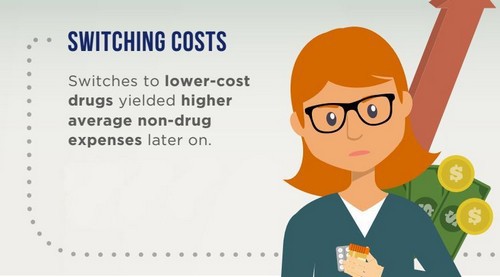Definition: Switching costs are the expenses associated with changing from one brand, service, or supplier to another. These costs can be both financial and non-financial in nature. Some of the common switching costs examples can be the cost to cancel an existing service contract or the time and effort needed to migrate data from one provider to another.
When deciding to switch a service provider, it is important to consider the costly ramifications of such a move – these costs are referred to as switching costs. For many, switching brands can be a daunting task — especially if considerable costs are involved.
Switching costs can come in a variety of forms, including those that are monetary (e.g., switching fees) and non-monetary (e.g., the time and effort needed to evaluate alternative options). Even emotional ties may factor into these decisions – such as loyalty towards or deviation from specific brands.
Table of Contents
What are Switching Costs?
Switching costs are the costs that customers are supposed to bear when they switch providers. It includes any monetary or non-monetary costs associated with the transfer, such as time and effort in researching other providers, the disruption of service when switching, or any costs associated with learning a new system.
Shoppers pay switching costs in the form of extra expenses such as setup and cancellation fees. A simple definition of switching costs, also known as switching barriers, is by Thompson and Cats-Baril who define it as “the costs associated with switching suppliers”. On the same lines, Farrell and Klemperer refer to it as “a consumer faces switching costs between sellers when an investment specific to his current seller must be duplicated for a new seller”.
In short, it is any cost – tangible or intangible – that a consumer has to bear when changing between brands, products, or suppliers. Since a buyer’s product specification, purchasing cycle, production equipment, and other factors are directly proportional to the present supplier’s production and operation, switching between suppliers is bound to cost money, time, effort, and other factors to the buyer and this cost is referred to as Switching Costs for the buyer.
Key Takeaways!
- Switching costs refer to the expenses incurred by a consumer during the process of shifting from one brand or product to another.
- These expenses can be categorized as monetary, effort-based, psychological, or time-based costs.
- To retain their customers, companies try to create high switching costs.
- It is important for companies to understand their customers’ switching costs in order to build and maintain customer loyalty.
Why are Switching Costs important?
Switching costs are important because they create high switching costs for customers, which encourages them to stay with the same provider or product. It creates a barrier to entry for new competitors, thus reducing competition and limiting consumer choice.
Additionally, it reduces the likelihood of customers taking advantage of better offers from other suppliers. This helps businesses build customer loyalty and increase loyalty over time. Furthermore, it reduces the amount of money and resources that companies need to invest in marketing and advertising to attract new customers.
Switching costs are invaluable in driving sales and familiarizing shoppers with your brand. After all, when the cost of changing stores is too high, customers will continue to return or never switch at all – meaning you’re certain to experience either stagnant or growing revenue.
The high switching cost companies may signify that their products and services are more unique than the competition. This can help capture consumers’ attention and build recognition of their brands.
How Switching Costs Work
Businesses can experience a range of costs when switching suppliers – from investing time and effort in the transition process to facing risks associated with disruption during this period. Cancellation fees or lack of suitable product replacements may also be incurred, making it vital for business owners to identify these potential expenses beforehand.
To maintain their success, companies will often invoke high switching costs on consumers to make it more difficult for them to switch from one product or brand to another. As a result, these firms can protect themselves from the competition and retain customer loyalty in an increasingly competitive marketplace.
Types of Switching Costs
When it comes to understanding switching costs and their types, you can divide them into two broad categories: low-cost and high-cost. Ultimately, the expense discrepancy is determined by how straightforward the transition process is as well as if similar services or products are offered by competing organizations.
1) Low Switching Costs
Characterized by minimal transition processes and many substitutes, low switching costs are usually related to cost-effective services or products. This is the reason why it’s not a major loss for either customers or organizations when they switch from one product to another. An example of low switching cost companies would be swapping out your current mobile phone provider with another.
2) High Switching Costs
Conversely, transitioning to another product or service can be quite expensive due to the lack of replacements and intricate transfer processes. For example, when changing from one advanced software system to another, it takes a heavy toll as employees must now learn how to use unfamiliar technology.
Common Switching Costs Companies Use
Some of the common switching costs that a company may use for hampering its existing customers to going to any competitor’s products or services are –
1. Exit fees
Companies may charge customers a fee if they opt to switch or terminate their services. Through cost incurred as an exit fee, companies are more likely to keep consumers from leaving them for their competitors – just like gym memberships that often impose hefty fees when canceling early.
2. Convenience cost
Businesses that offer quick and convenient services often entice customers to stay. People would rather stick with a brand they are familiar with than switch to one that requires more effort or lifestyle changes for them to get the same products. Companies can retain their customer base by providing accessible access to what people need.
3. Time cost
Certain companies purposefully extend their switching process, making it complicated and time-consuming to dissuade customers from ending the service or transferring to another provider.
4. Effort cost
Companies could create lengthy and complex exit procedures that make it difficult for consumers to switch providers, potentially trapping them in a cycle of significant effort and long-term contracts.
5. Emotional connection cost
Companies often attempt to foster an emotional bond between their team and customers to drive loyalty and further purchases. It offers them a competitive advantage.
6. Learning cost
For customers, the process of getting familiar with new brands, products, or services carries a learning cost. This may be in the form of training costs, trial and error expenses, or other investments. They may also need to invest effort in understanding how to transfer their data or other assets from one provider to another. This learning cost can be a major barrier to switching and encourages customers to remain with the same company.
7. Direct Switching Costs
Also known as procedural switching costs, these are the immediate switching costs that a consumer incurs when switching products, services, or suppliers. To explain this cost, let us take the example of a firm that is looking to change the supplier that maintains its IT network.
8. Financial Switching Costs
It refers to the switching costs incurred as a loss of financially quantifiable assets. Let us consider the example taken above. The firm looking for a new supplier for IT maintenance might have to pay a “Contract penalty cost” to the old supplier when switching suppliers.
9 Relational Switching Costs
It refers to the psychological distress caused to the consumer due to identity loss and the breaking of bonds with the current supplier. Example – If you had a huge problem with an existing vendor, if he was not supplying material on time, or if the quality of the product was inferior, then the relations with the existing supplier are poor which comes under this. Relational switching costs can be both – positive and negative in nature.
This is a video by Marketing91 on Switching Costs.
How it helps organizations?
Understanding the switching costs of their products or services can help organizations price their offerings fairly. Let us consider a scenario where a consumer is offered the lowest price for a new product or service but has to face switching costs (that can be in terms of money, effort, uncertainty, and other reasons) that exceed the current price of the product or service they currently use.
In such a scenario, a rational consumer would not switch to the new product and remain loyal to the old product or service. In this case, the firm offering the old product or service can marginally increase the price of their offerings and still have the consumer remain loyal to them.
Strategies Employed by Companies
When a company is able to make customers pay more, it gives them an edge over the competition. Companies often use a variety of tactics to raise the switching costs that customers must bear. Take for example:
- Charging a hefty fee for canceled services
- Crafting a lengthy, intricate process for canceling services
- Submitting a burdensome amount of paperwork to cancel services
Examples of Switching Costs
Our everyday life is filled with examples of switching costs. The effort required to learn how to use a new home appliance from a different brand comes under switching costs. The time spent waiting for a new supplier to provide raw materials for your production also comes under switching costs as does the cost associated with changing the telecom carrier a consumer has been associated with.
If you are comfortable with the Windows operating system, you will not shift to a Macbook because of the huge time spent and the huge switching costs associated with learning a new product. However, if you wanted to try a new soap, you can do that with no cost associated with the switching.
There are other similar examples of switching costs. Firms dealing with Apparel typically have very low switching costs for consumers since it is comparably easy to find another good deal on apparel by visiting multiple shops in the same vicinity.
In essence, those companies that have products that are easily replicated by competitors at equivalent prices tend to have low switching costs. On the other hand, those products that are not easy to replicate and need considerable effort on the part of the buyer would always have high switching costs.
An example of high switching costs will be the time and effort taken to learn a new Keyboard layout when switching from the existing QWERTY keyboard layout to a new keyboard layout. In cases where the switching costs are extremely high, firms offering that product or service have the propensity to have a monopoly in the market of that particular product or service.
Conclusion!
In the end, we hope you would have understood the concepts and usability of switching costs. High switching costs can become an expensive, time-consuming hassle for customers and hence may hamper them from switching.
This can lead to financial losses that make it difficult or impossible for them to switch to the new service provider. And companies use this strategy to optimize customer retention and loyalty.
Liked this post? Check out the complete series on Marketing



N8ce
hi, can you help me wtih my homework please??
it’s about this topic….. and i need to know ,
what are the strategic behaviors of companies and customers……
I need to compare with “Fat Cat” and “Lean and hungry look” please can u reply??